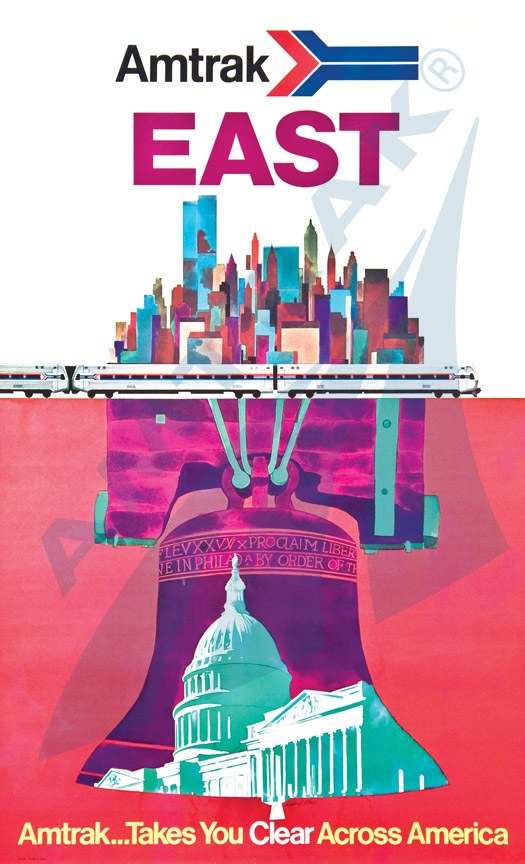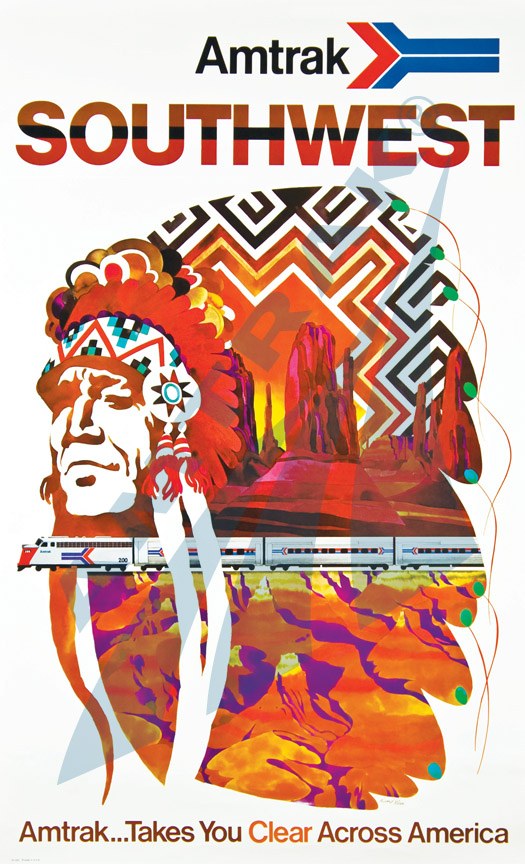Digging into the Archives: The Art of David Klein
CommentsMarch 14, 2013
In an effort to expose travelers to its services in the early 1970s, Amtrak hired acclaimed illustrator David Klein to design a series of posters highlighting train travel. Klein had made his name in travel advertising through a fruitful relationship with Trans World Airlines (TWA) during the 1950s and 1960s. His work for the airline featured posters of the carrier’s many destinations, including Greece and India and cities such as Paris, Rome and London. For the most part, Klein used bright colors, bold fonts and abstractions of local landmarks or typical “national characters” to communicate the excitement and discovery associated with world travel.
The Eiffel Tower, surrounded by fireworks, dominates a Paris poster, while a jet plane flies above. For New York, Klein depicts Times Square through abstract black highrises that are the perfect backdrop for a dizzying array of layered colored rectangles that call to mind the intersection’s electronic signs and television screens. For Spain, Klein drew on the image of the bullfighter, outfitted in a black montera hat and blue traje de luces whose rich gold embroidery sparkles in the Andalusian sunlight. Klein’s commissions for TWA garnered him numerous prizes and awards, and those posters are now considered evocative of an optimistic post-war age in which travel in general, and air travel specifically, became more accessible to the American middle class.
For Amtrak, Klein created a set of five 25”x40” posters, using the tagline “Amtrak…Takes You Clear Across America” to emphasize the railroad’s mandate to operate a national, intercity passenger rail system. Three of the posters celebrate regions of the country, including the East, Southwest and Northwest; one highlights Florida; and one draws attention to the Northeast’s high-speed Metroliner Service between Washington and New York.
Images and color are used to effectively tell the story of each region. The face of an American Indian dominates the Southwest poster. His ceremonial headdress dissolves into a geometric pattern reminiscent of those found in the region’s American Indian pottery and textiles. An Amtrak train led by a locomotive in Phase I livery divides a majestic desert scene; above are towering stone formations while below is a landscape riven with canyons. Through the use of red, orange, yellow, brown and purple color tones, Klein evokes the Southwest’s dry, warm deserts. Bright turquoise, used sparingly, directs the viewer's eye to the band of the headdress. Klein's use of American Indian figures and motifs to represent the Southwest calls to mind advertisements created by the Atchison, Topeka and Santa Fe Railway, from which Amtrak had taken over operation of the Super Chief (Chicago-Los Angeles) in 1971.
In the Florida piece, vivid pink flamingos frolic under a warm glowing sun. With their sly glances, they beckon the viewer to hop aboard the gleaming train running across the lower end of the poster. Symbols of the “Land of Sunshine,” such as Disney World’s Cinderella Castle and a rocket blasting off from Cape Canaveral, are framed by the birds’ bodies and long, elegant legs. Florida probably got its own poster because the state was a prime tourist destination served by four daily trains: the Champion (New York-St. Petersburg); Silver Meteor (New York-Miami); Silver Star (New York-St. Petersburg/Miami); and the Floridian (Chicago-Tampa-St. Petersburg/Miami). Amtrak heavily promoted Florida-bound travel through various tour packages such as the “Week of Wheels in Florida” and “Florida Carrousel.” These deals bundled train travel with hotel stays, car rentals and other amenities.
The Metroliner poster features a high-speed Budd electric car built originally for the Pennsylvania Railroad. At its onset, Amtrak absorbed a number of passenger rail services including that of the Penn Central Transportation Company, which was formed in 1968 through the merger of the Pennsylvania Railroad and the New York Central Railroad. With the assistance of the federal government, the company had developed the electric-powered Metroliners for use on its busy main line between Washington, D.C. and New York City. Luxurious cars and fast running times made it a viable competitor to regional airlines, and new stations were built outside of Washington and New York to attract riders who had left center cities for the suburbs. Under Amtrak, Metroliner Service frequencies increased to keep up with demand.
In a booklet put together to mark Amtrak's 10th anniversary in 1981, the Metroliner was described as “the most significant piece of equipment on Amtrak’s roster…[they] were the only proven, new high-speed cars extant at that time…these all-reserved-seat speedsters demonstrated unequivocally the public acceptance of new, innovative passenger rail equipment
By angling the train so that it disappears into the lower left hand corner of the poster, Klein provides a sense of speed, which is only enhanced by the sleek car body and the white motion lines against the golden background. Amtrak’s patriotic red, white and blue color scheme is also prominently displayed on the end of the car, as is the company’s first service mark.
Klein’s work for Amtrak proved quite popular with the public; within a few months of their release, the posters could be ordered individually or as a set. According to advertisements in the national timetables, each one cost $1.50, or the lot could be had for $6.
Amtrak posters hang on the wall of the ticket
office in New London, Conn. in spring 1975.The Amtrak Archives has no images of the posters in use, but I did stumble upon an interesting photograph of the New London, Conn. station taken in April 1975 for the Historic American Buildings Survey. It clearly shows the Metroliner poster on the ticket office wall. The poster hanging a few feet away looks like it could be the Southwest, as the size and general layout appear correct.
Today, David Klein’s work is highly sought after by collectors of advertising and poster art, as he is viewed as a definitive master who influenced the fields of illustration and graphic design in the latter half of the twentieth century. Amtrak, the country's first truly national passenger railroad, is proud to be part of his artistic legacy.







